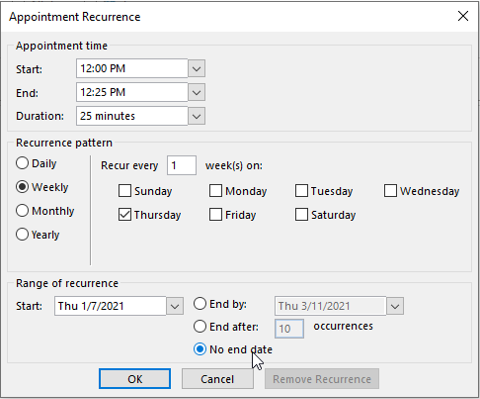For a short time, your new year calendar looks so clean and clear… Not at all like the clogged days of last year, with those squeeze-it-in-before-the-holidays meet-ups and the reviews and evaluations of how it was all going even as it was still all going…
A brand new calendar is a beautiful thing – especially the vast blank expanses that hold the promises of opportunity, of productivity, and maybe even of time off. Lovely, and definitely wall-worthy décor.
However, many of us are now driven primarily by digital calendars. Desktop, laptop, tablet, phone, watch – watch out: Wherever you go, you should know when to be doing what. Handy, yes, but also a bit invasive.
But wait – you run your calendar, right? No? If you feel your calendar’s running you, now (right now!) might be the perfect time to gain some ground.
Recurring Questions
A huge difference between digital and physical calendars is the ability to set a meeting as “recurring”. In just a few clicks, a one-off can be converted into a never-ending chain of more of the same. (How scary is it to click “No end date”?)

Yes, technology is amazing. However, this automation often drives us to keep showing up without thinking through our plans and purposes.
Any time is the right time for this kind of review, but a brand new year (month/quarter/whatever) is the best. As you review each recurring item on your calendar, ask yourself these questions:
- What’s the actual purpose of this meeting?
- Are the right people included on the invitation?
- Is this this meeting scheduled at the right frequency/interval?
- Does the scheduled amount of time make sense for the purpose?
- Does this day/time work for those involved?
More purposeful meetings
If you don’t know why you’re meeting, take it off of the calendar. Generally speaking, your purpose might be something like:
- Team/individual check-in on a specific project
- Making decisions to drive strategy
- 1:1 check-in on personal goals
- Training/development
- Building culture and community
On a more granular layer, most meetings benefit from a common reference. Whether it’s a document or a tool of some kind, a tracker allows participants to recall details and action items from the last meeting, to keep up with the current meeting, and to plan for next steps. No matter the form – a notes doc, a Trello board – the reference also allows your team members to check in and drop notes between meetings so nothing is lost.
An event on your calendar might have multiple purposes, and that’s okay. Building community is always one of my purposes, but there are always plenty of other moving parts, too. It’s when you have no idea why some leftover event is still sticking to your calendar that it’s time to take out the trash.

Invitation-only
Based on your purpose, who needs to be present for your meeting? Who needs to be included to help finalize decisions? Who needs to be involved so they understand their follow-up action items? Avoid pre- and post-meeting repetition by having the right people on the call in the first place. Make sure that invitations are sent well in advance to the correct email addresses and that they include the appropriate connection details, links, and agenda items. When your invitees don’t have clarity on the goals of your meeting, you’re already starting behind.
Who doesn’t need to be present? Check the guest list and remove those who are no longer with the company or no longer involved in the project. If you’re inviting senior leaders, consider how to make the best use of their time. Especially in long or frequently occurring meetings, you might ask for senior leaders to join for key segments or sessions.
Interval training
We’ve all been in meetings that result in a surprisingly long list of action items – often associated with a surprisingly short list of assignees – and a plan to meet again the next day to check in on progress. Sometimes the plan is actually to meet later the same day. Yikes! How can anything possibly get done in the interim?
For particularly high-intensity projects, it sometimes does make sense to meet on a daily basis, but consider this: The more time spent meeting, the less time spent doing. If the team is coming together to make decisions that are holding up progress, great. If a meeting is simply a person-by-person accounting for progress made since the last meeting, make better plans. Whether it’s a project management tool or even a really amazing spreadsheet, share progress in real time to avoid taking the time to explain it.
Have this conversation with your meeting attendees. What’s a realistic interval for meetings – weekly? Every other week? Monthly? It’s both embarrassing to report and annoying to listen when there’s really no progress to share.
Take (no more than) all the time you need
Are all of your meetings scheduled for exactly an hour? Do all of your meetings require exactly an hour? Can you possibly end one meeting and start the next at exactly the same time? So many questions.
From a technical perspective, use calendar features like Google’s speedy meetings setting to automatically allow some breathing room between your meetings.

Then, reflect on your most recent meetings on this topic or in this series. Were you able to accomplish your objectives? Did you need to rush through, or did you have extra time at the end? While it’s perfectly acceptable to end a meeting early, meetings often expand to fill the space they’re given on the calendar. If your meeting can be 20 minutes instead of 30 or 45 instead of 60, you’ll be giving your participants the time they probably need to follow up on their action items, prep for their next calls, and maybe even snag that dreamed-of cup of coffee. ?
Is it good for you?
It’s true that “having fun” isn’t always the primary purpose for a meeting, but “inspiring dread” shouldn’t be anywhere on the list, either. Is this meeting worth your participant’s time? Inviting someone to a meeting means asking them to set aside anything else they’re doing and come and pay attention to something that you think is important. If you’ve followed all of the best practices listed above, there’s a pretty good chance this person would benefit from attending your meeting. Still, the key question remains: When?
Being respectful of your participants’ time means paying attention to the timing of your meetings – especially if they’re recurring. You can get away with a Friday afternoon session if the real purpose is “to reflect on the week and connect with the team informally”, but fitting your meeting into the natural cycles of the day, week, month, quarter, or year can make it much easier for your participants to tune in and focus on the purpose at hand. Some team members prefer to meet in the morning, some live in a different time zone, some like to run at lunchtime. Those in sales and finance are busier at the end of the month, development and support team members are busier at key points in the product release cycle, and some content team members prefer to set aside their afternoons for writing. Some have more flexibility during school hours, and some prefer to work after their kids are in bed.
Not sure when your team should meet? Ask. We all need to be flexible from time to time, but the more people who are happier with the meeting time, the happier your meeting can be.

Make Meetings Matter
Beyond recurring meetings, closely examine the time you’re putting on your calendar – and on others’ calendars. Discuss your etiquette as a team: Is it okay for people to put something on your calendar without asking you first? What details must be included in the invitation itself? Where will meeting resources be stored?
Have a discussion with your team about making any standing meetings (recurring) into stand-up meetings (literally stand throughout!). If occasionally the team sees no grounds for the meeting, allow them to stand down and cancel it. (If you can’t stand any more of this outstanding wordplay, create your own upstanding examples!)
Finally, check the space between your meetings – that beautiful, wide open negative space that allows for such positive productivity. Consider protecting that space – 1-2 pm, Thursday afternoon, Mondays – by setting up a work block to dedicate to actually getting things done. After all, checking off those action items is a definite step in making your next meeting even better.














